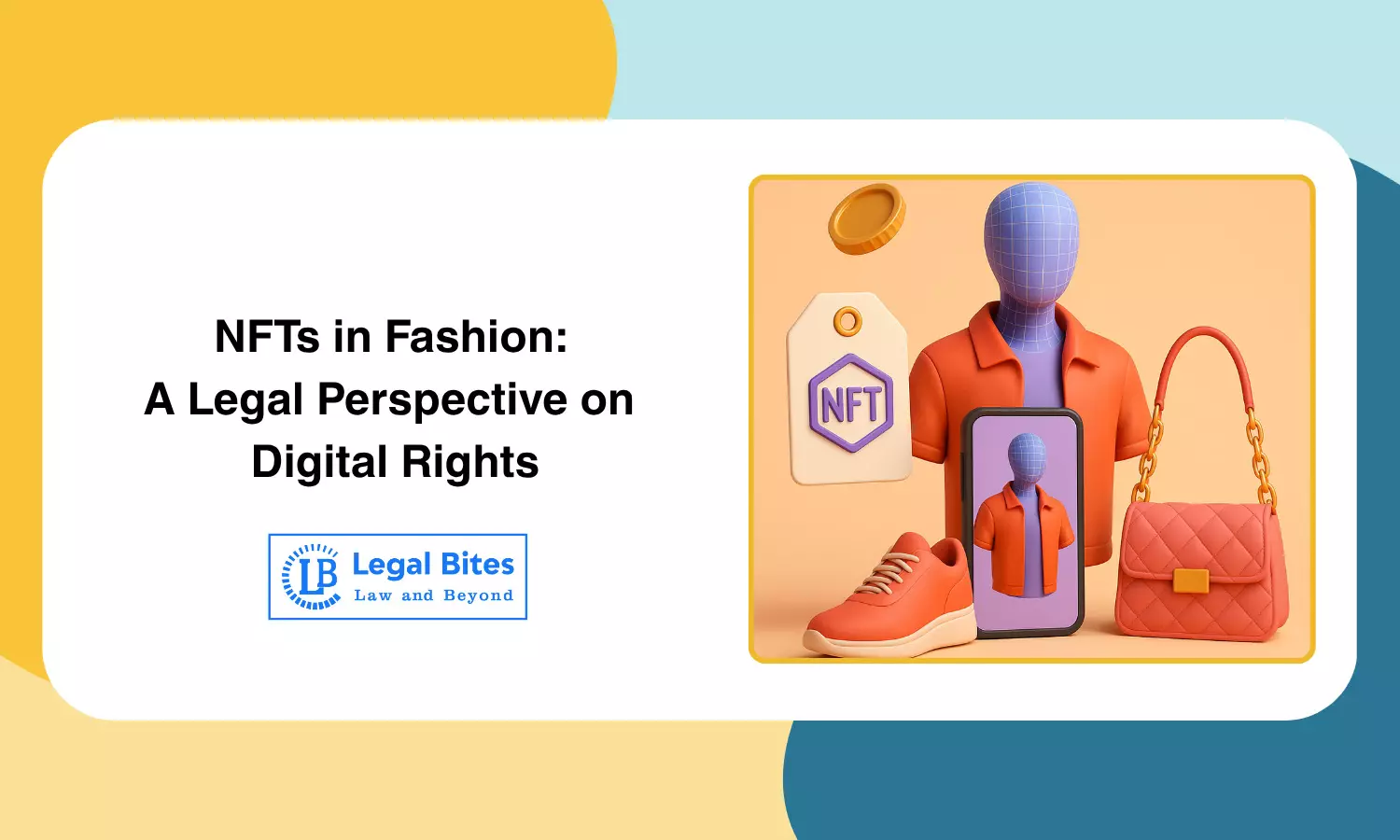NFTs in Fashion: A Legal Perspective on Digital Rights
NFTs and digital fashion are reshaping the creative economy by redefining artistic expression, ownership, and value in the evolving digital landscape.

The digital revolution has left no industry untouched, and fashion is no exception. From virtual runway shows to AI-generated designs, fashion has embraced technology in manifold ways. One of the most transformative developments is the integration of Non-Fungible Tokens (NFTs), which offer a new realm of opportunity for designers, artists, and consumers alike.
NFTs provide a mechanism for certifying ownership and authenticity of digital fashion assets on the blockchain. In India, this phenomenon is gaining momentum, opening doors to new legal, economic, and creative dimensions.
Understanding NFTs in the Fashion Context
NFTs are cryptographic tokens stored on blockchain networks that represent ownership of unique digital items. In fashion, these tokens can be linked to digital sketches, 3D garment designs, virtual accessories, and even AR/VR-compatible clothing. Unlike fungible cryptocurrencies, NFTs are non-interchangeable, ensuring that each piece is distinct and verifiable.
Key Features of Fashion NFTs:
- Authenticity: Each digital fashion item is verifiable and tamper-proof.
- Provenance: Ownership history is recorded on the blockchain.
- Scarcity: Limited-edition drops enhance the value.
- Royalties: Creators earn automatically from resale, depending on platform capabilities.
India’s Foray: Manish Malhotra and the WazirX NFT Marketplace
India’s entry into fashion NFTs was pioneered by couturier Manish Malhotra, in collaboration with WazirX NFT Marketplace and FDCI X Lakmé Fashion Week. In 2021, he dropped five exclusive fashion NFTs, which sold out within seconds—a testament to both the designer’s reputation and the growing appetite for digital ownership among Indian audiences.
This collaboration marked a pivotal moment for the Indian fashion industry, demonstrating the commercial viability of fashion NFTs and the potential for creators to explore a new revenue stream.
Legal Framework for Digital Fashion Rights in India
The emergence of digital fashion raises critical questions around intellectual property (IP), especially in jurisdictions like India, where IP law is still catching up with digital innovation.
1. Copyright and Digital Designs
Under the Copyright Act, 1957, original artistic works are protected. Digital fashion sketches and designs can qualify as artistic works if they meet the originality requirement. However, enforcement in digital contexts remains challenging, particularly when copied and distributed across decentralised platforms.
2. Design Protection
The Designs Act, 2000 protects the visual features of shape, configuration, pattern, or ornamentation. Digital renditions may qualify if they are capable of being applied to a physical product. However, purely virtual designs—such as those used only in metaverse environments—may fall into grey areas under existing statutes.
3. Trademark Implications
Fashion brands deploying NFTs must ensure that their trademarks are adequately protected in virtual environments to prevent misuse or dilution. This includes filing for trademark registration under new classes such as Class 9 (software) or Class 42 (technology services) in addition to traditional fashion-related classes.
4. Smart Contracts and Ownership
Smart contracts—self-executing contracts coded into NFTs—ensure royalties and ownership transfers without intermediaries. However, their legal enforceability under Indian contract law (Indian Contract Act, 1872) remains to be tested in courts.
NFTs as a Revenue and Engagement Model
Fashion NFTs offer multiple economic benefits, particularly for designers, artisans, and creators who have traditionally relied on physical sales and fashion shows for visibility and revenue.
Benefits Include:
- Royalties on Resales: Creators earn a percentage every time the NFT changes hands.
- Fan Engagement: Brands can offer exclusive experiences, loyalty tokens, or early access to collections via NFTs.
- Virtual Fashion Shows: Designers can monetise attendance to virtual runways via NFT tickets.
Digital Fashion in the Global and Indian Market
Global Trends
Luxury brands like Gucci, Dolce & Gabbana, and Burberry have already made significant strides into NFTs and the metaverse. Gucci’s “SuperGucci” NFTs and D&G’s Collezione Genesi were sold for hundreds of thousands of dollars.
Indian Trends
Indian menswear designer Raghavendra Rathore has launched a limited edition NFT collection featuring his personal artwork and brand-inspired designs on the WazirX NFT Marketplace, in collaboration with FDCI and Lakmé Fashion Week. For the first time, these NFTs aimed to raise awareness for his NGO, the Raghavendra Rathore Foundation (RRF), with part of the proceeds supporting mentorship, cultural engagement, and scholarship initiatives for community empowerment.
Platforms like WazirX and Jupiter Meta are hosting NFTs across art, music, and now fashion.
Startups and tech ventures are collaborating with fashion schools to digitise fashion IP.
Challenges in the Indian Context
Despite growing interest, there are several hurdles:
- Legal Uncertainty: There is no clear legislation or case law defining the ownership and enforceability of digital fashion assets in India.
- Limited Awareness: Many designers, especially traditional ones, are unfamiliar with blockchain and NFT technology.
- Taxation Issues: GST and capital gains implications on NFT sales are still evolving, adding to financial uncertainty.
- Platform Dependence: Most NFTs are dependent on marketplaces (like OpenSea, WazirX) for visibility and enforcement of royalties, limiting direct control by creators.
Future of Fashion NFTs in India
India’s young, digitally savvy population and deep cultural heritage make it an ideal breeding ground for fashion NFTs. As digital fashion grows, we can expect:
- Fashion institutes to include blockchain in their curricula.
- Government policies to adapt to address virtual IP rights.
- Sustainable fashion integrating NFTs to reduce physical production waste.
- Metaverse Fashion Week: NFTs and digital fashion represent a transformative shift in the creative economy by redefining how artistic expression, ownership, and value are perceived in the digital realm
Conclusion
The scope of digital fashion rights in India is poised for exponential growth. With trailblazers like Manish Malhotra paving the way and platforms like WazirX building the infrastructure, NFTs are emerging as a new frontier for fashion innovation. However, to unlock their full potential, legal clarity, education, and broader adoption are essential. If leveraged wisely, NFTs can not only protect and monetise digital fashion assets but also democratize access and appreciation for Indian design globally.
References
- The Copyright Act, 1957
- The Designs Act, 2000
- Manish Malhotra becomes India’s first fashion designer to launch NFT, Available Here
Raghavendra Rathore becomes the first designer to use NFTs to raise funds for a cause
, Available Here

